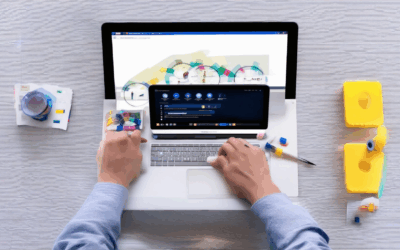Website navigation design is the cornerstone of any successful online presence, serving as the backbone that guides users seamlessly through your site. A poorly designed navigation system can leave visitors lost and frustrated, driving them away from your platform. Conversely, a well-crafted navigation layout can enhance user experience, keep visitors engaged, and improve conversion rates. In this article, we’ll explore the ins and outs of website navigation design, offering insights into organizing your site’s structure, choosing the right menu templates, and leveraging effective navigation styles to create a user-friendly interface. Whether you’re looking to refine an existing design or build a new one from scratch, this guide will provide you with actionable strategies and practical tips to master the art of website navigation.

What is Navigation in Website Design?
Navigation in website design refers to the system of links and menus that allow users to move through a website efficiently. It serves as the backbone of user experience, guiding visitors to the information, services, or features they seek while ensuring the site is easy to navigate.
The Importance of Navigation
- User Experience: Effective navigation reduces frustration and simplifies finding content, improving user satisfaction.
- SEO: Properly structured navigation can enhance your site’s crawlability and indexability by search engines, indirectly boosting your SEO performance.
- Content Accessibility: Clear navigation helps screen readers and assistive technologies understand the site’s structure, making it more accessible to everyone.
Types of Navigation
- Top Navigation: Commonly found at the top of a webpage, it includes primary navigation links like Home, About Us, Services, Contact Us, etc.
- Side Navigation: Located on the left or right side of the page, it typically includes secondary or tertiary links.
- Bottom Navigation: Found at the bottom of the page, it’s often used for quick access to key sections like Footer Links or Legal Information.
- Contextual Navigation: Appears within a specific page or section to help users explore related content.
Best Practices for Effective Navigation
- Keep It Simple: Use a clean and intuitive design to minimize confusion. Avoid overcrowding the navigation bar with too many links.
- Hierarchy of Links: Establish a logical hierarchy with primary, secondary, and tertiary links. Primary links are usually at the top level, while secondary and tertiary links are nested under them.
- Consistency: Use consistent labeling and styling across all pages to reduce cognitive load and make the site feel cohesive.
- Mobile-Friendly Design: Optimize navigation for mobile devices, ensuring that links are easily accessible and touch-friendly.
- Use Descriptive Labels: Label links clearly to help users understand where clicking will take them.
- A/B Testing: Continuously test different navigation layouts to identify what resonates best with your audience and improves user engagement.
Tools for Creating Great Navigation
- WordPress Navigation Plugins: Tools like WordPress’ Customizer or plugins like “Nav Menu” help customize your site’s navigation.
- CSS Frameworks: Bootstrap, Foundation, and Tailwind CSS offer responsive navigation components that adapt to various screen sizes.
- SEO Tools: Screaming Frog or SE Ranking can crawl and analyze your site’s navigation structure to identify issues.
By implementing these principles and tools, you can create a navigation system that enhances user experience, supports SEO efforts, and ensures your website is accessible and easy to navigate.
How to Organize Website Navigation
A well-organized website navigation enhances user experience and improves SEO performance. Here’s a step-by-step guide to effectively organizing your website’s navigation:
- Define Your Site Structure: Start by mapping out your website’s main sections such as Home, About Us, Services, Portfolio, Blog, Contact Us, etc.
- Include a Logo and Branding: Place your logo prominently in the navigation bar for easy recognition and brand consistency. Use consistent fonts and colors throughout the menu for a cohesive look.
- Add Primary Navigation Links: Highlight your most important pages or sections with primary navigation links. These typically appear at the top of the page or in a sticky header.
- Consider Mobile Responsiveness: Ensure your navigation is mobile-friendly. On smaller screens, hide text links behind a hamburger menu or collapsible drawer for better usability.
- Use Internal Linking Strategically: Link to popular or related content within your site to improve SEO and keep users engaged. Use descriptive anchor text that matches the destination page’s content.
- Limit Menu Items: Keep the navigation simple. Aim for 5-15 main menu items. Add additional links in a footer or sidebar if needed.
- Incorporate Icons for Clarity: Use relevant icons to represent sections like Checkout, Search, or User Profile to enhance visual appeal and improve usability.
- Test and Optimize Regularly: Continuously test your navigation layout using tools like Hotjar or Google Analytics to see how users interact with your menu. Adjust based on user behavior and feedback.
- Maintain Consistency Across Pages: Ensure your navigation appears and functions the same way on every page to avoid confusion and improve overall site consistency.
- Make It Accessible: Use alt text for icons and ensure the menu is functional for screen readers. Keyboard navigation should also be tested to meet accessibility standards.
By following these guidelines, you can create a navigation system that is both user-friendly and search engine optimized, driving better engagement and conversions.

Three Main Types of Website Navigation
The navigation system on a website plays a crucial role in user experience and functionality. Below are the three primary types of website navigation, along with examples and best practices for implementation:
1. Global Navigation
Global navigation typically appears at the top of a webpage, often referred to as a header. It provides links to main sections of the website, allowing users to move between different areas easily.
- Examples: Links such as “Home,” “About Us,” “Services,” and “Contact Us.”
- Functionality: Global navigation is ideal for helping users access key pages quickly, reducing the need to navigate deeper into the site.
- Design Considerations: Ensure the global navigation is consistent across all pages and includes links to important sections like privacy policies and FAQs.
2. Hierarchical Navigation
Hierarchical navigation organizes content into a tree-like structure, allowing users to explore categories and subcategories. This type of navigation is particularly useful for large websites with a lot of content.
- Examples: Categories like “Technology,” “Sports,” and “Entertainment” with subcategories such as “Smartphones,” “Football,” and “Movie Reviews.”
- Functionality: Users can click on a main category to view related content, making it easier to find specific information.
- Design Tips: Use breadcrumb trails to show users their location within the site hierarchy, improving usability.
3. Local Navigation
Local navigation is used within specific sections of a webpage, such as on a product page or blog post. It helps users find related content without needing to return to the main site.
- Examples: Links to related products, recommended articles, or navigation within a specific blog post.
- Purpose: Enhances user experience by providing quick access to complementary content.
- Implementation: Use tabs, ribbons, or floating navigation bars to integrate local navigation seamlessly.
Best Practices for Effective Navigation
- Consistency: Maintain a uniform navigation style across all pages to reduce confusion.
- Mobile-Friendly Design: Ensure navigation works well on mobile devices, possibly with collapsible menus like hamburger panels.
- SEO Optimization: Include descriptive anchor text and ensure that primary navigation links are crawlable by search engines.
- A/B Testing: Experiment with different navigation layouts to determine which performs best for your audience.
By understanding and effectively implementing these navigation types, website owners can enhance user experience, improve site structure, and boost SEO performance.

What are the four rules for designing great navigation?
The four essential rules for designing effective navigation are:
- Rule 1: Establish Clear Content Hierarchy
- Organize content into a logical structure that prioritizes important information.
- Use hierarchical layers such as primary, secondary, and tertiary navigation.
- Ensure that users can easily find what they’re looking for without confusion.
- Rule 2: Maintain Consistent Design Elements
- Keep the design style consistent across all pages to create a cohesive user experience.
- Use the same color schemes, typography, and spacing throughout the site.
- Consistency helps users recognize and navigate the site more efficiently.
- Rule 3: Prioritize Mobile-Friendly Design
- Ensure that navigation is responsive and works seamlessly on all devices.
- Mobile-first design principles should guide the creation of the navigation system.
- Simple and touch-friendly interfaces are critical for mobile users.
- Rule 4: Regularly Test and Optimize
- Conduct usability tests to identify issues in the navigation system.
- Analyze user behavior and feedback to continuously improve the design.
- A/B testing different navigation layouts can help determine the most effective design.
What Are the 3 Basic Rules of Navigation?
Navigation is essential for boaters and sailors to safely navigate waterways and avoid collisions. Here are the fundamental principles every skipper should follow:
- Always Have a Lookout :
Having a properly trained lookout is non-negotiable. This person ensures you never miss something critical, like another vessel or an obstruction in the water. They should be stationed at the bow or a high vantage point and use signals effectively. - Control Your Speed :
Operating at a safe speed reduces the risk of accidents. Speed limits are in place for a reason, so adhere to them. Slowing down in busy areas or near unfamiliar waters can prevent unexpected encounters. - Yield to Others :
Whether you’re under sail or power, always yield to smaller vessels, slower-moving traffic, and those who seem unsure of themselves. This proactive approach minimizes the chance of a collision and promotes harmony on the water. - Avoid Collisions at All Costs :
Even if it means breaking a rule, your priority is to prevent harm to people and property. Stay vigilant, especially in crowded areas or narrow channels. - Know Your Boat and the Environment :
Understanding your vessel’s capabilities and the surrounding conditions is key. Plan ahead, check weather forecasts, and stay aware of potential hazards like rocks, shoals, or submerged obstacles.
By following these guidelines, you can navigate confidently and responsibly, ensuring safety for everyone on board. Always stay alert and prepared for changes in the environment.

The Three Main Types of Navigation
Navigation systems play a crucial role in helping individuals locate their position and navigate through various environments. Below are the three primary types of navigation systems:
- Celestial Navigation
- GPS Navigation
- Map and Compass Navigation
Celestial Navigation
Celestial navigation relies on the positions of stars and planets to determine location. This method has been used for centuries and is particularly effective in remote areas where other forms of navigation may not work. Celestial navigation requires a good understanding of astronomy and the ability to calculate positions using star charts.
GPS Navigation
Global Positioning System (GPS) navigation is one of the most widely used and reliable methods today. GPS uses satellites to provide precise location data, allowing users to track their movements in real-time. GPS navigation is commonly used in vehicles, smartphones, and outdoor equipment. Its accuracy makes it ideal for both recreational and professional purposes.
Map and Compass Navigation
Map and compass navigation combines traditional tools to help users find their way. A compass provides directional information, while a map shows the overall layout of an area. This method is often preferred in off-road or challenging terrains where electronic devices may not function properly. Practicing with a map and compass can enhance navigational skills and preparedness.
Each of these navigation systems has its strengths and is suited for different scenarios. Whether you’re traveling internationally, driving locally, or exploring the wilderness, having a combination of these tools can ensure you always find your way.




0 Comments